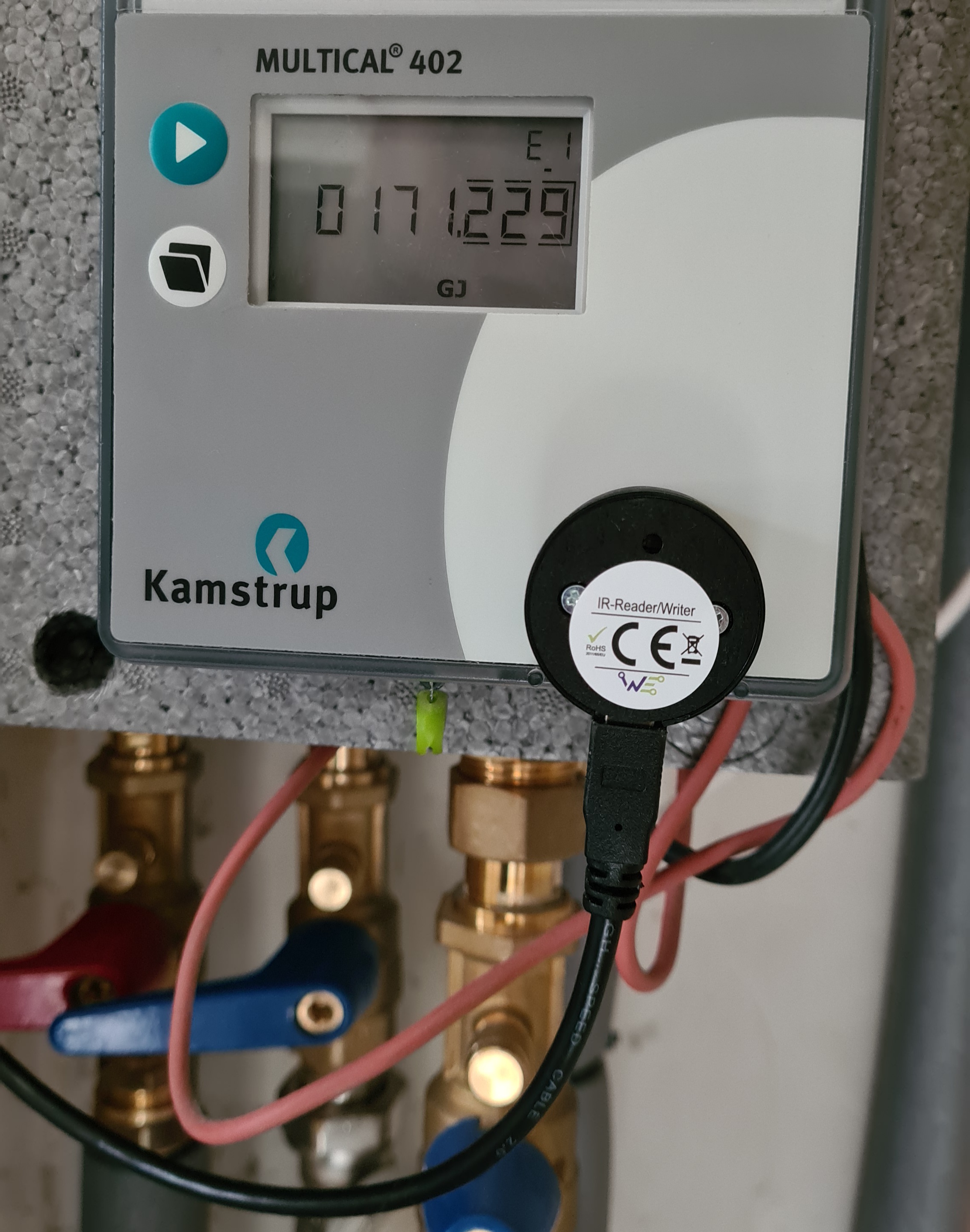This project provides a Python library that enables communication with the Kamstrup Multical 402 heat meter. The configured parameters will be read from the meter at a certain interval and published in MQTT messages. This guide uses Linux as a base operating system.
- Kamstrup multical 402 MQTT library
- Contents
The following software and packages are required to run the script via the commandline or as a service
- Python 3
- MQTT broker e.g.: Mosquitto
- See Docker requirements to run the project as a docker container.
Required hardware
- Infrared read/write USB cable e.g.: IR Schreib/Lesekopf USB (Optokopf) or something simulair.
The library can be configured to fit your needs using the config.yaml file. The parameters of this file are described below.
| parameter name | description |
|---|---|
| host | MQTT broker host domain name or IP address |
| port | MQTT broker port number |
| client | Client name to identify this MQTT client e.g. Kamstrup |
| topic | MQTT topic where the values are published on |
| retain | If set to true, the message will be set as the "last known good"/retained message for the topic |
| qos | The quality of service level to use for the message. Cane be any value between 0 and 2 |
| authentication | Set this to true if your MQTT broker requires authentication |
| username | Username to connect to broker |
| password | Password to connect to broker |
| com_port | port of serial communication device |
| parameters | List of parameters that are read and published to the configured MQTT topic. See Meter parameters table. |
| poll_interval | Meter readout interval in minutes (value should be less than 30 to prevent the meter from going in standby mode |
These parameters can be added to the config.yaml file. Atleast one parameter must be present in the configuration file.
| parameter name | description |
|---|---|
| energy | consumed energy in GJ |
| power | |
| temp1 | incoming temperature in degrees |
| temp2 | outgoing temperature in degrees |
| tempdiff | difference between temp1 and temp2 in degrees |
| flow | water flow in l/h |
| volume | consumed water in m3 |
| minflow_m | minimum water flow |
| maxflow_m | minimum water flow |
| minflowDate_m | |
| maxflowDate_m | |
| minpower_m | |
| maxpower_m | |
| avgtemp1_m | |
| avgtemp2_m | |
| minpowerdate_m | |
| maxpowerdate_m | |
| minflow_y | |
| maxflow_y | |
| minflowdate_y | |
| maxflowdate_y | |
| minpower_y | |
| maxpower_y | |
| avgtemp1_y | |
| avgtemp2_y | |
| minpowerdate_y | |
| maxpowerdate_y | |
| temp1xm3 | |
| temp2xm3 | |
| infoevent | |
| hourcounter |
The script can be started by simply starting the daemon file with Python 3.
python3 daemon.py &The & will start the Python script as a daemon process. The following output is a example of what to expect in the log file when the meter is receiving actual data from the meter.
mqtt_handler.py publish: 46 - INFO - Publishing 'kamstrup/values' '{"energy": 227.445, "volume": 2131.935, "temp1": 52.81, "temp2": 39.94}' to 10.0.0.210:1883]By subscribing to the configured mqtt topic on the MQTT broker we can view these messages. You can use MQTT Explorer for debugging to test the MQTT part.
Edit the kamstrup_meter.service file and adjust the path accordingly. The working directory in this example is /opt/kamstrup/.
[Unit]
Description=Kamstrup2mqtt Service
After=multi-user.target
[Service]
Type=simple
WorkingDirectory=/opt/kamstrup
ExecStart=/usr/bin/python3 /opt/kamstrup/daemon.py
StandardOutput=null
StandardError=journal
Restart=always
[Install]
WantedBy=multi-user.targetCheck if the service has the required permissions after copying, if not, change it with chmod and chown.
cp /opt/kamstrup/kamstrup_meter.service /etc/systemd/system/
sudo systemctl daemon-reload
sudo systemctl enable kamstrup_meter.service
sudo service kamstrup_meter startMake sure the following is installed:
**Docker-compose is optional but useful and easy to configure.
Build a docker image "kamstrup"
docker build -t kamstrup .Edit the docker-compose.yml file and adjust the "devices" parameter accordingly. Syntax is:
<Path must match usb device --> /dev/ttyKamstrup:/dev/ttyKamstrup <-- Inside container, must match path of config.yml>Initial start of the container:
docker-compose up -dThe container should run now and produce output via Mqtt. If not, check the logging in logs.
After the initial start of the container it can be stopped and started again with the folowing commands:
docker start kamstrup_kamstrup_1
docker stop kamstrup_kamstrup_1
docker restart kamstrup_kamstrup_1Check if the container is running with:
docker statsIt can be hard to find the correct position of the meter head. It might differ if you are using an other model. I positioned the infrared head as follows:
This section includes some tips to solve some issues.
The log file will, in most cases, spoil what going on if something's not working.
tail -f debug.logIf you have any troubles with retrieving the values from the meter, make sure that the meter is 'awake', you can do so by pressing any button on the meter. It is also important that you've positioned the meter head correctly. I may take a while to find the sweet spot. For some reason the position for the meter head that I've got is a little bit higher than what the distance keepers on the meter suggest.
Unplug the usb connector from the computer and plug it back in. Use dmesg to find the com port.
dmesg


